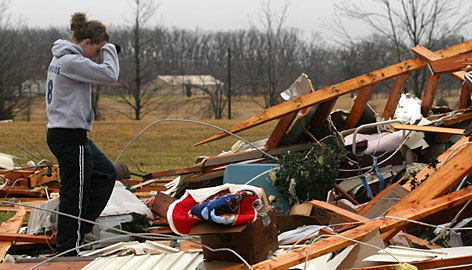
Extremes Becoming More Extreme: Wild Weather Battered USA in January
Larry Wheeler
 February 1, 2008
February 1, 2008
By Larry Wheeler
Gannett News Service
WASHINGTON — Rare winter tornadoes in the Midwest. Powerful Pacific storms with hurricane force winds. More than 1,000 daily high temperature records. And that's just in the first month of 2008.
Is January the new March?
Photo: Melina Edmonds pauses while going through the wreckage of her grandmother's tornado-damaged home near Strafford, Mo., Tuesday, Jan. 8, 2008. An outbreak of severe weather Jan. 7 through Jan. 10 spawned 48 tornadoes across the Midwest and Southeast. (By Mark Schiefelbein, AP)
Weather extremes are nothing new for this country. It's a big place that experiences lots of variability — more so than most other places, according to weather and climate experts.
But are the extremes becoming more extreme?
Some government researchers tracking Earth's climate say yes.
"We're seeing an increasing trend in the frequency of extremes," said Karin Gleason, a meteorologist who compiles the U.S. Climate Extremes Index maintained by the National Climatic Data Center in Asheville, N.C.
The index is a nationwide composite of indicators that includes extreme temperatures, drought, one-day precipitation events and number of days with or without precipitation.
"When you combine all the individual indicators, we're seeing a steady increase from the early 1970s to present," said Gleason.
In 2007, nearly 42% of the contiguous U.S. experienced extreme weather events, the second highest for the index, which incorporates records dating back to 1910.
Last year was one of the 10 warmest on record. It was marked by deadly and costly wildfires that led to the largest evacuation in California history, spring storms that unleashed 600 tornadoes across the Great Plains and South, severe flooding in Texas and Oklahoma, and extreme drought across much of the Southeast, according to a preliminary report from the National Oceanic and Atmospheric Administration's climate center.
"It certainly seems like something ominous is going on when you experience these extremes," said Gregory Berg, an assistant professor of music at Carthage College in Kenosha, Wis.
On Jan. 7, Berg photographed a tornado as it formed less than two miles from campus. His snapshot of the wispy twister appears on the National Weather Service website as part of the agency's report on the event.
"When you see something so unexpected, you feel like you're seeing a unicorn or something," said Berg, who also hosts "The Morning Show" on the local National Public Radio affiliate.
Among the most extreme of all weather events are tornadoes, violent columns of rotating air that have cut a long and tragic path of death and destruction through U.S. history.
Tornadoes raked northern Illinois and southern Wisconsin in early January, a rare event in midwinter.
But it's too soon to know whether these unusual storms represent a significant shift, said John T. Snow, a tornado expert and Dean of the College of Atmospheric & Geographic Sciences at the University of Oklahoma.
"Are we seeing more tornadoes than we did, say, 50 years ago? The way we see things, you really can't tell," said Snow.
Population growth, 24-hour cable TV and Internet weather reports and advances in weather radar have contributed to an increase in the number of reported tornadoes. But that doesn't prove an increase in their actual occurrence, Snow said.
Early January was unusually warm, breaking or tying daily maximum temperature records in more than 1,000 locations during the first days of the month.
The inevitable clash between cold, arctic air and warm, moist southern air helped spawn the unusual midwinter storms, according to meteorologists.
By the end of the month, extreme weather had returned to the nation's midsection. On Jan. 28, daytime temperatures in Wisconsin, for example, plummeted in a matter of hours from the mid-40s to near zero, with overnight wind chill temperatures at 25 degrees below zero.
Are these extremes evidence of global warming?
"January tornadoes and more heat records is something you would expect in a warming climate," said Jeff Masters, director of meteorology at Weather Underground, a popular meteorology website.
But many scientists aren't ready to say the weather has turned more extreme because the planet is warming.
"There is a lot of natural variability in our weather systems," Masters said. "Climate change is only just now barely beginning to be evident in the observations. That's why there is so much controversy."
http://www.usatoday.com/weather/news/2008-01-31-wild-january-weather_N.htm
www.standeyo.com/NEWS/08_Earth_Changes/080201.extremes.more.ext.html
